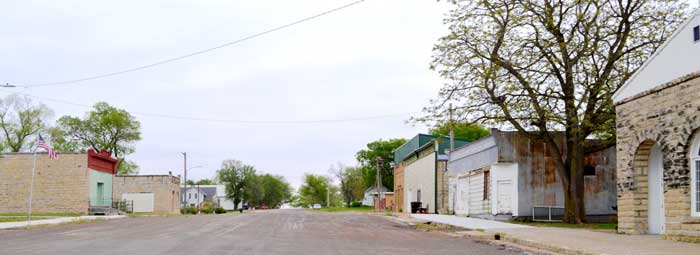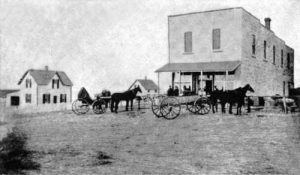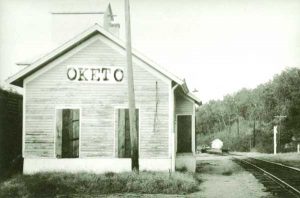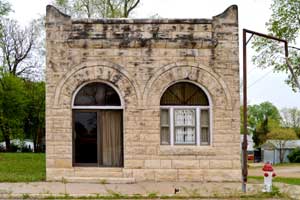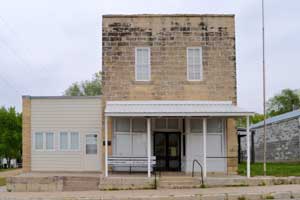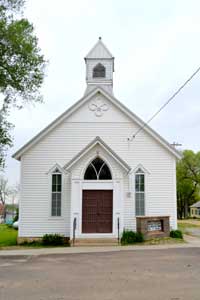Getting its start as a trading point on the Big Blue River in the 1860s, Oketo, Kansas, was named for a chief of the Otoe tribe, Arkaketah.
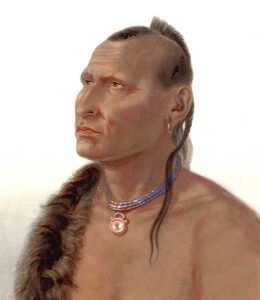
Otoe Indian Man
Oketo is one of the oldest points to claim settlement in Marshall County. During the Mormon exodus and early rush for the western goldfields, many travelers took a shortcut from a point that afterward became known as Robidoux Station, which was a mile north of what became Guittard Station, to this crossing. There were hunters, trappers, and Indians along the Blue River in those days, and this crossing was favorably located for winter quarters, having the advantage of being on a trail where the hunters could sell game and hides. This spot was located about a mile south of the present-day Oketo.
In 1857 J. H. White settled on section 13, Oketo Township. By this time, other “squatters” had come in, William Bond, Val Poor, and others had taken land, and some attempts at permanent settlement were made. In the early 1860s, J. H. Whitehead came to the ford and built a store, barn, and residence. These buildings were on the east side of the Blue River. The nearest post office on the east was Guittard Station and on the south Marysville. In 1862 Ben Holladay decided to construct the Oketo “cut-off” on the Overland Stage line and employed George Guittard to do the work. The road being opened, J.H. Whitehead was put in charge of the station and also managed the ferry that Holladay had built.
At that time, two saloons were in operation — one on the east side and one on the west side of the Blue River. The keen business sense was evidenced in this arrangement as the same parties owned both. On the east side, 20¢ was charged for a drink of whiskey; on the west, 25¢ was the toll. Going east, passengers could soon obtain refreshments, but westward the stations were farther apart, and there was a consequent lapse of time between drinks. The little settlement with its big barn, blacksmith shop, and store was attractive, and scores of Indians congregated there to barter, quench their thirst with “tarantula juice,” and watch for the Overland Stage.
In the fall of 1864, Whitehead sold out to Asa Simpson, and in the summer of 1865, the barn was burned. The store and dwelling had also been set on fire but were saved by the stage boys. With no barn on the east side, Holladay moved the station to the west side of the river. With the stage, the big barn, the store, and the ferry passing, the original Oketo declined as a business point.
In 1866 Irving Chapman built a dam across the Blue River and put up a flour mill. Soon after, Z.H. Moore established a store and later built a house. The firm of Moore & Esterbrook opened fine stone quarries, and this industry soon diverted settlement to that point. This industry was a valuable one for the growing town. The quality of the stone was unsurpassed, and found a ready market in Lincoln, Beatrice, Grand Island, and other towns of Kansas and Nebraska. A large number of men were employed in the quarries.
A “new” Oketo was officially established on the Marysville and Blue Valley Railroad line and incorporated as a city in 1870. A post office was established in May 1873.
In 1900, the community reached its peak population of 347. By 1910, the Union Pacific Railroad was providing transportation for agricultural products, and the town boasted banking facilities, express and telegraph offices, and a population of 253.
In 1917, the town boasted a substantial bank, three grain elevators, a flour mill, a lumber yard, implement stores, a harness shop, a blacksmith shop, a barbershop, a drug store, a hotel, an electric light plant, well-graded schools, a well-attended Methodist church, a full city government of women, and a newspaper. At that time, it was described as:
“The clean little town with substantial, even pretentious homes and well-kept lawns, situated on a hill commanding a wide view of the surrounding country, challenges the admiration of the visitor.”
Over the years, the population fell, though it continues to support just about 64 people today, still has a post office, and is still incorporated. Oketo is located ten miles north of Marysville.
There are several interesting buildings and sites that represent Oketo’s history that can be seen.
The Oketo Museum operates from the old Z.H. Morre Store. This 1884 building is on the National Register of Historic Places. The museum has Otoe Indian artifacts, early telephone equipment, and replicas of a barbershop and a general store. It is open by appointment. Oketo State Bank Building, dating from the early 1900s, is also part of the Oketo Museum. The bank was established in 1889 by Z. H. Moore.
Oketo City Hall was called the “Opera House” when it was first built in 1900. Traveling stock companies produced plays here for winter entertainment. It is now used as a community center.
Oketo jail. Built in 1895, and equipped with rings on the floor for chaining prisoners.
Moore house, 1904. General store and quarry owner Z. H. Moore and his wife Lavinia could not agree on building a stone or frame house, so the first story is limestone, and the second is frame with shingle siding.
Oketo Cut-off marker. A shortcut was used for several months in 1862-63 after the owner of the Overland Stage line had a falling-out with Marysville and decided his stagecoaches would bypass that town altogether. Just south of the marker is the grave of Louis Tibbets, who died in June 1861. On 12th road .3 mi south of Cherokee Road.
Oketo stage line marker. On Cherokee Road just west of 11th Road.
Redtop/Scully School. “Scully” was the name of a wealthy Irish family which owned and rented out thousands of acres in Marshall County and elsewhere in the Midwest. This building was used from 1898 until 1953. At 14th and Cherokee Roads.
©Kathy Alexander/Legends of Kansas, updated February 2023.
Also See:
Sources:
Blackmar, Frank W.; Kansas: A Cyclopedia of State History, Vol I; Standard Publishing Company, Chicago, IL 1912.
Cutler, William G; History of Kansas; A. T. Andreas, Chicago, IL, 1883
Forter, Emma; History of Marshall County, Kansas: Its People, Industries, and Institutions, F. Bowen, 1917
Marshall County
Kansas Historical Society
Wikipedia

